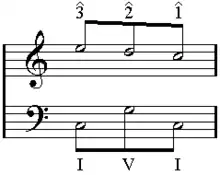Structural level
In Schenkerian analysis, a structural level is a representation of a piece of music at a different level of abstraction, with levels typically including foreground, middleground, and background.[1] According to Schenker musical form is "an energy transformation, as a transformation of the forces that flow from background to foreground through the levels."[2]

For example, while details such as melodic notes exist at the lowest structural levels, the foreground, in the background the fundamental structure is the most basic structural level of all tonal music, representing the digression from and necessary return to the tonic that motivates musical form. It may be conceived of in a specific piece as the opening in the tonic and the return to the tonic with a perfect authentic cadence (V-I) after the development of sonata allegro form.
Strata is the translation given by John Rothgeb for Schichten ("Levels") as described by Oswald Jonas in his Introduction to the Theory of Heinrich Schenker.[3] This translation did not gain wide acceptance in modern Schenkerian literature and the translation of Schichten as "levels" usually has been preferred.[4]
See also
Sources
- Bello, Juan Pablo, ed. (2008). Kirlin, Philip B. and Utgoff, Paul E. "A Framework for Automated Schenkerian Analysis", ISMIR 2008, p.363. ISBN 978-0-615-24849-3.
- Heinrich Schenker, Der freie Satz, 1935, §301. See Free Composition, Appendix 4, text P (translation by J. Rothgeb).
- Jonas, Oswald (1982). Introduction to the Theory of Heinrich Schenker, p.138. (1934: Das Wesen des musikalischen Kunstwerks: Eine Einführung in Die Lehre Heinrich Schenkers). Trans. John Rothgeb. ISBN 0582282276.
- The word "strata" can be found in L. D. Blasius, Schenker's Argument and the Claims of Music Theory (Cambridge, 1996), alongside "level". It appears once in M. Brown, Explaining Tonality (University of Rochester Press, 2005), p. 138, in a quotation from J. Rothgeb's translation of a text from The Masterwork in Musik, vol. I; Brown otherwise prefers "level". It is not used in F. Salzer, Structural Hearing (Boni, 1952), in A. Forte and S. E. Gilbert, Introduction to Schenkerian Analysis (Norton, 1982), or in E. Aldwell, C. Schachter and A. Cadwallader, Harmony and Voice Leading (Schirmer, 2011), etc., where "level" is used exclusively.
